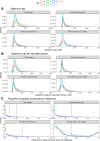Inequity of healthcare access and use and catastrophic health spending in slum communities: a retrospective, cross-sectional survey in four countries
- PMID: 34844998
- PMCID: PMC8633995
- DOI: 10.1136/bmjgh-2021-007265
Inequity of healthcare access and use and catastrophic health spending in slum communities: a retrospective, cross-sectional survey in four countries
Abstract
Introduction: Tracking the progress of universal health coverage (UHC) is typically at a country level. However, country-averages may mask significant small-scale variation in indicators of access and use, which would have important implications for policy choice to achieve UHC.
Methods: We conducted a retrospective cross-sectional household and individual-level survey in seven slum sites across Nigeria, Kenya, Bangladesh and Pakistan. We estimated the adjusted association between household capacity to pay and report healthcare need, use and spending. Catastrophic health expenditure was estimated by five different methods.
Results: We surveyed 7002 households and 6856 adults. Gini coefficients were wide, ranging from 0.32 to 0.48 across the seven sites. The total spend of the top 10% of households was 4-47 times more per month than the bottom 10%. Households with the highest budgets were: more likely to report needing care (highest vs lowest third of distribution of budgets: +1 to +31 percentage points (pp) across sites), to spend more on healthcare (2.0 to 6.4 times higher), have more inpatient and outpatient visits per year in five sites (1.0 to 3.0 times more frequently), spend more on drugs per visit (1.1 to 2.2 times higher) and were more likely to consult with a doctor (1.0 to 2.4 times higher odds). Better-off households were generally more likely to experience catastrophic health expenditure when calculated according to four methods (-1 to +12 pp), but much less likely using a normative method (-60 to -80 pp).
Conclusions: Slums have a very high degree of inequality of household budget that translates into inequities in the access to and use of healthcare. Evaluation of UHC and healthcare access interventions targeting these areas should consider distributional effects, although the standard measures may be unreliable.
Keywords: cross-sectional survey; health economics; health policy; health systems evaluation.
© Author(s) (or their employer(s)) 2021. Re-use permitted under CC BY. Published by BMJ.
Conflict of interest statement
Competing interests: None declared.
Figures



References
Publication types
MeSH terms
LinkOut - more resources
Full Text Sources
Miscellaneous
